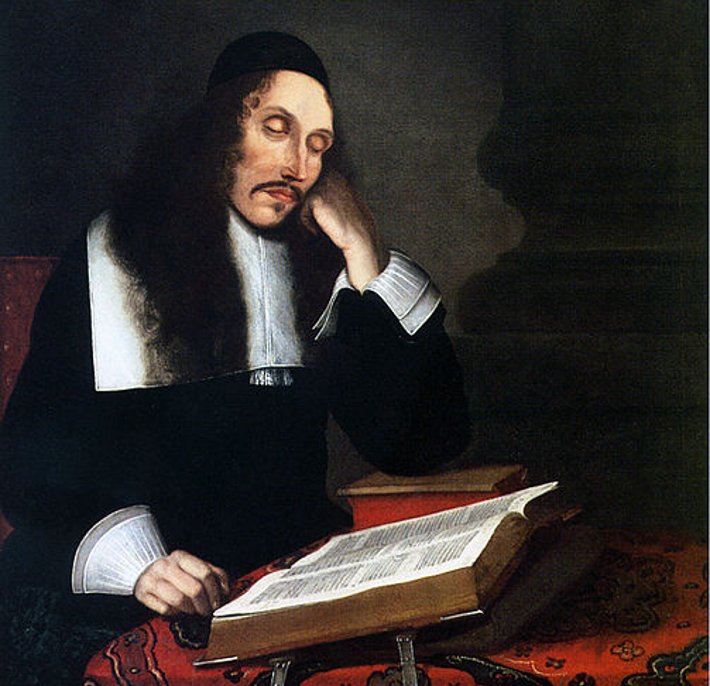Baruch Spinoza

Baruch Spinoza, Latinised Benedict de Spinoza (1632-1677) was a Jewish-Dutch philosopher whose work played the key role in formation of the modern Western thought. By rejecting the Descartes’ mind-body realism and the traditional presentation of God by the Jewish and Christian traditions, Spinoza paved the way to modern rationalism. The importance of his work, however, was realised only after his premature death.
Background
Baruch Spinoza was born in 1632 as the second son of Miguel de Espinoza and his second wife Ana Debora in Amsterdam, the Netherlands. His father was a successful merchant of Portuguese Jewish origin. Young Spinoza was raised up in the Portuguese Jewish community in Amsterdam that grew significantly after the Spanish Alhambra Decree (1942) and the Portuguese Inquisition (1536), both of which resulted in forced conversions to Christianity and expulsions from Spain and Portugal. Many Sephardic Jews including the so-called ‘conversos’ emigrated to the Netherlands, especially after the Decree of Toleration that was issued in 1579. Here, they reconverted to Judaism and built the first synagogue in 1598.
Early Life
Young Spinoza was without a doubt influenced greatly by the Jewish community in Amsterdam. He was brought up as a Jew and attended the yeshiva (Jewish educational institution with a focus on the study of religious texts). He learned from the traditional Rabbi Saul Levi Morteira as well as the less traditional Manasseh ben Israel who is best known for founding the first Hebrew printing press in the Durch capital. For some reason, young Spinoza never reached the advanced study of the Torah. At the age of 17, he left the formal education and started to work in the family business. This was probably influenced greatly by the death of his older brother Isaac in the same year.
At the age of 20, Spinoza began to study Latin. He was taught by Franciscus Van den Enden, a former Jesuit who was notorious for his secular thought. It is believed that van den Enden made a major impression on Spinoza and that he probably introduced him to the concepts of scholasticism and early modern philosophers such as Descartes. After his father’s death one year later (1654), Spinoza took over family business with his younger brother Abraham. At the same time, he adopted his Latinised name Benedictus de Spinoza and started to teach at Van den Enden’s school. It is speculated that he was in love with Van den Enden daughter Clara who, however, rejected him.
In his early 20s, Spinoza came in contact with anti-clerical Christian groups that opposed the traditional dogmas and the church’s authority. His radical Christian friends questioning the religious authorities and his teacher Van den Enden who introduced him to modern philosophy probably played an important role in his conflict with the Jewish religious authorities in Amsterdam. Spiroza allegedly said that God has a body and that there is nothing in the holy texts to say otherwise. In 1656, the Talmud Torah congregation issued cherem against Spinoza by which he was expelled from the Jewish community. He did not, however, convert to Christianity although he was close with the Christian sect of the Collegiants and was buried in a Christian cemetery. According to Yitzhak Melamed, Associate Professor of Philosophy at the Johns Hopkins University, Spinoza was the first modern European secular Jew.
Later Life
At the time cherem was issued against Spinoza, his family business came into serious financial difficulties. He left over the business along with the debts to his younger brother and dedicated himself to philosophy and optics for the remaining 21 years of his life.
Shortly after the cherem was issued, the Amsterdam authorities responded to the concerns of the rabbis and expelled Spinoza from the city. He moved to the village of Ouderkerk aan de Amstel nearby but he soon returned to Amsterdam and stayed there until 1660 or 1661, earning a living by grinding lenses and giving private philosophy lessons. During this period, he also wrote his first philosophical work titled “Short Treatise on God, Man, and His Well-Being”. In 1660 or 1661, he moved to Rijnsburg where he wrote “Principle of Cartesian Philosophy” (published in 1663). There, he also began to work on his greatest masterpiece – “The Ethics” which was published only after his death.
In 1663, Spinoza moved to Voorburg where he continued to work on “The Ethics” as well as other works. In 1670, he published “Theological Political Treatise” in which he supported Jan de Witt, the Grand Pensionary of Holland against William II, Prince of Orange as Stadtholder of Holland who later became William III of England. According to Leibnitz, Spinoza seriously jeopardised his life by supporting de Witt. Despite the fact that he published the “Theological Political Treatise” anonymously, the authorship was soon revealed. The Synod of the Reformed Church condemned the work in 1673 and officially banned it one year later.
In 1770, Spinoza left Voorburg and moved to The Hague where he spent the last years of his life living from a small pension and annuity from his dead friend’s brother. He continued to work on the “Ethics” but he also wrote a Hebrew grammar (unfinished), scientific essays “On the Rainbow” and “On the Calculation of Chances” and started a Dutch translation of the Bible which he later gave up and destroyed.
Spinoza fell ill in 1776 and died one year later, aged 45. The cause of his death is not exactly clear. He is said to die from a lung disease which could have been related to inhalation of glass dust while he was grounding lenses. He never married and did not have any children.
Works
- A Short Treatise on God, Man and His Well-Being (1660-1661)
- On the Improvement of the Understanding (1662)
- The Principles of Cartesian Philosophy (1663)
- Theological Political Treatise (1670)
- The Ethics (1677)
- Hebrew Grammar (1677)